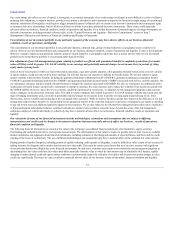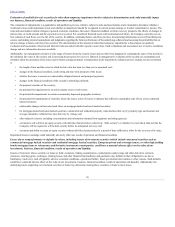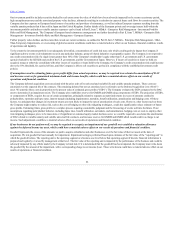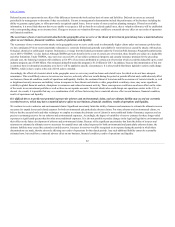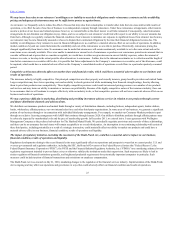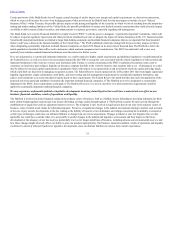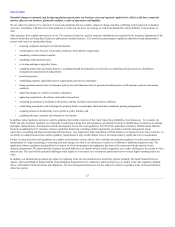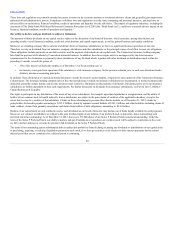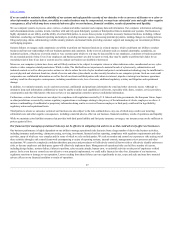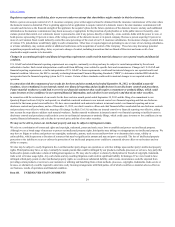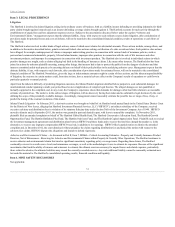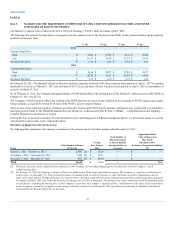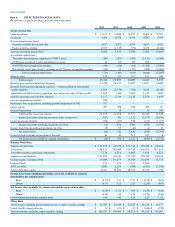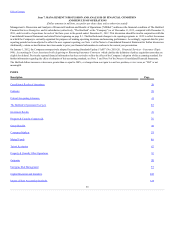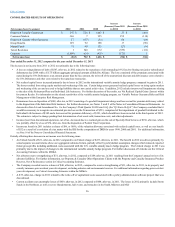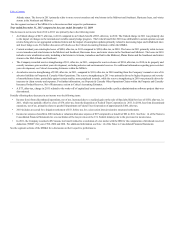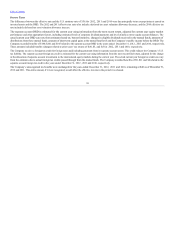The Hartford 2012 Annual Report Download - page 29
Download and view the complete annual report
Please find page 29 of the 2012 The Hartford annual report below. You can navigate through the pages in the report by either clicking on the pages listed below, or by using the keyword search tool below to find specific information within the annual report.
Table of Contents
Regulatory requirements could delay, deter or prevent a takeover attempt that shareholders might consider in their best interests.
Before a person can acquire control of a U.S. insurance company, prior written approval must be obtained from the insurance commissioner of the state where
the domestic insurer is domiciled. Prior to granting approval of an application to acquire control of a domestic insurer, the state insurance commissioner will
consider such factors as the financial strength of the applicant, the acquirer's plans for the future operations of the domestic insurer, and any such additional
information as the insurance commissioner may deem necessary or appropriate for the protection of policyholders or in the public interest. Generally, state
statutes provide that control over a domestic insurer is presumed to exist if any person, directly or indirectly, owns, controls, holds with the power to vote, or
holds proxies representing 10 percent or more of the voting securities of the domestic insurer or its parent company. Because a person acquiring 10 percent or
more of our Common Stock would indirectly control the same percentage of the stock of our U.S. insurance subsidiaries, the insurance change of control laws
of various U.S. jurisdictions would likely apply to such a transaction. Other laws or required approvals pertaining to one or more of our existing subsidiaries,
or a future subsidiary, may contain similar or additional restrictions on the acquisition of control of the Company. These laws may discourage potential
acquisition proposals and may delay, deter, or prevent a change of control, including transactions that our Board of Directors and some or all of our
shareholders might consider to be desirable.
Changes in accounting principles and financial reporting requirements could result in material changes to our reported results and financial
condition.
U.S. GAAP and related financial reporting requirements are complex, continually evolving and may be subject to varied interpretation by the relevant
authoritative bodies. Such varied interpretations could result from differing views related to specific facts and circumstances. Changes in U.S. GAAP and
financial reporting requirements, or in the interpretation of U.S. GAAP or those requirements, could result in material changes to our reported results and
financial condition. Moreover, the SEC is currently evaluating International Financial Reporting Standards (“IFRS”) to determine whether IFRS should be
incorporated into the financial reporting system for U.S. issuers. Certain of these standards could result in material changes to our reported results of
operation.
In connection with the restatement of our results for the three and nine month period ended September 30, 2012, we identified a material
weakness, since remediated, in our internal control over financial reporting and an ineffectiveness in our disclosure controls and procedures.
Future material weaknesses could lead to errors in our financial statements that could require a restatement or untimely filings, which could
cause investors to lose confidence in our reported financial information, and a decline in our stock price and that of our other securities.
In connection with the restatement of our results for the three and nine month period ended September 30, 2012 and the filing of an amendment to our
Quarterly Report on Form 10-Q for such period, we identified a material weakness in our internal control over financial reporting and that our disclosure
controls for that same period were ineffective. We have since remediated such material weakness in internal control over financial reporting and in our
disclosure controls and procedures, and as of December 31, 2012, our chief executive officer and chief financial officer concluded that our disclosure controls
and procedures were effective within the meaning of Exchange Act Rule 13a-15(e) and that our internal control over financial reporting was effective, taking
into account the steps taken to address such material weakness. Further material weaknesses in internal control over financial reporting or ineffectiveness in
disclosure controls and procedures could result in errors in our financial statements or untimely filings, which could cause investors to lose confidence in our
reported financial information, and a decline in our stock price and that of our other securities.
We may not be able to protect our intellectual property and may be subject to infringement claims.
We rely on a combination of contractual rights and copyright, trademark, patent and trade secret laws to establish and protect our intellectual property.
Although we use a broad range of measures to protect our intellectual property rights, third parties may infringe or misappropriate our intellectual property. We
may have to litigate to enforce and protect our copyrights, trademarks, patents, trade secrets and know-how or to determine their scope, validity or
enforceability, which represents a diversion of resources that may be significant in amount and may not prove successful. The loss of intellectual property
protection or the inability to secure or enforce the protection of our intellectual property assets could have a material adverse effect on our business and our
ability to compete.
We also may be subject to costly litigation in the event that another party alleges our operations or activities infringe upon another party's intellectual property
rights. Third parties may have, or may eventually be issued, patents that could be infringed by our products, methods, processes or services. Any party that
holds such a patent could make a claim of infringement against us. We may also be subject to claims by third parties for breach of copyright, trademark,
trade secret or license usage rights. Any such claims and any resulting litigation could result in significant liability for damages. If we were found to have
infringed a third-party patent or other intellectual property rights, we could incur substantial liability, and in some circumstances could be enjoined from
providing certain products or services to our customers or utilizing and benefiting from certain methods, processes, copyrights, trademarks, trade secrets or
licenses, or alternatively could be required to enter into costly licensing arrangements with third parties, all of which could have a material adverse effect on
our business, results of operations and financial condition.
29


